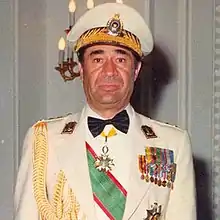Abdol Ali Badrei | |
|---|---|
 | |
| Born | 29 March 1921 Kermanshah, Qajar Iran |
| Died | 11 February 1979 (aged 57) Tehran, Islamic Republic of Iran |
| Allegiance | Imperial Iranian Army |
| Service/ |
|
| Years of service | 1941–1979 |
| Rank | Lieutenant General |
| Commands held |
|
| Other work | |
| Cause of death | Shooting |
Abdol Ali Badrei (29 March 1921 – 11 February 1979) was an Iranian lieutenant general and the last commander of the Imperial Iranian Army and the Imperial Guard. He was one of the hardline senior military officers[1] and was assassinated during the course of the regime change in Iran.
Early life and education
Badrei was born in Kermanshah on 29 March 1921.[2] He graduated from the military academy in Kermanshah and Tehran.[2]
Career
After graduation, Badrei joined the Imperial army as lieutenant in the Mounted Infantry.[2] His first mission was in 1946 to fight against rebels in Azerbaijan and Kurdistan Province.[2] Then he joined the imperial guards in 1946.[2] In 1967, he was promoted to the rank of brigadier general and served as second in command in the guards.[2] In 1971, he became a major general and was appointed commander of the immortal guards in 1973.[2] In 1975, he was made lieutenant general and was appointed commander of the imperial guards in 1976.[2]
In February 1979 Badrei publicly stated that the army would not follow the orders of Prime Minister Shahpour Bakhtiar.[3] Instead of being reprimanded by the Shah due to these remarks, he was named commander of the ground forces on 10 January,[1] succeeding Gholam Ali Oveissi, who had resigned from office and left Iran.[4][5] Badrei formed a group to carry a military coup on 10 February, just before the Iranian revolution.[6] He served in the post of the Imperial Ground Forces commander until his death on 11 February.[6]
Death
Badrei was assassinated on 11 February 1979 on the Sultanabad barracks which was the army headquarters in Tehran.[7][8] He was leading the troops of the Imperial Ground Forces loyal to the Shah which were fighting against armed civilians who were the supporters of Ayatollah Khomeini when he was murdered.[9] Scheherezade Faramarzi argued in 2019 that the murderer of Badrei was a teenager who was not aware of his identity.[7] Upon his assassination the Imperial army was easily disintegrated by the Islamic government.[9]
References
- 1 2 Jean-Charles Brotons (2010). U.S. Officials and the Fall of the Shah: Some Safe Contraction Interpretations. Lanham, MD: Lexington Books. pp. 69, 74. ISBN 978-0-7391-3340-8.
- 1 2 3 4 5 6 7 8 "Biography". Badrei website. Archived from the original on 31 July 2013. Retrieved 31 July 2013.
- ↑ Mark J. Roberts (January 1996). "Khomenei's incorporation of the Iranian military" (PDF). National Defense University. Archived from the original (McNair Paper 48) on 5 March 2016. Retrieved 31 July 2013.
- ↑ "A chronology of the Iranian Revolution (1978-79)". Derkelier. August 2008. Archived from the original on 2 May 2014. Retrieved 31 July 2013.
- ↑ "Key Iranian General Defects". Fort Lauderdale News. 10 January 1979. p. 6. Retrieved 9 August 2023.
- 1 2 Mohammad Sahimi (3 February 2010). "The Ten Days that Changed Iran". PBS. Archived from the original on 30 July 2013. Retrieved 31 July 2013.
- 1 2 Scheherezade Faramarzi (11 February 2019). "Remembering Iran's Revolutionary Days". Lobe Log. Archived from the original on 11 September 2021. Retrieved 20 March 2022.
- ↑ Thomas C. Reed; Danny B. Stillman (2008). "Revisiting the Seventies The Third World Comes of Age". IFQ. 51: 152. Archived from the original on 20 March 2022.
- 1 2 Javier Gil Guerrero (2016). The Carter Administration and the Fall of Iran's Pahlavi Dynasty. New York: Palgrave Macmillan. p. 184. doi:10.1057/9781137598738_10. ISBN 978-1-349-88805-4.
External links
 Media related to Abdol Ali Badrei at Wikimedia Commons
Media related to Abdol Ali Badrei at Wikimedia Commons